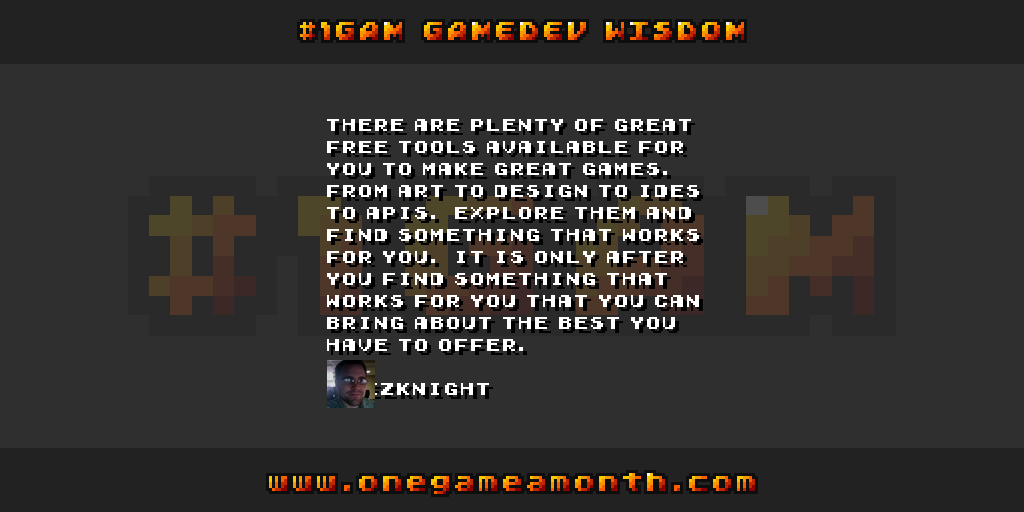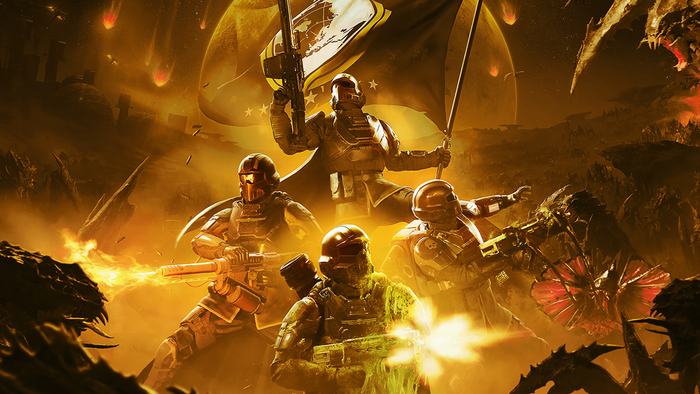
Featured Blog | This community-written post highlights the best of what the game industry has to offer. Read more like it on the Game Developer Blogs.
The Power Of Free: The Tools We Use
There are a LOT of tools available for game developers. This is the list of tools we use.

Originally Published On Divine Knight Gaming
Just yesterday, One Game A Month featured my words of wisdom on their twitter account. They had been posting these statements from various developers for the last few months as a way to promote those developers and the project. Here is what I had to say.
#gamedev wisdom by @ezknight via #1GAM http://t.co/fWDiThByAd 
— One Game A Month (@OneGameAMonth) February 17, 2015
If you can’t read it, here is what it says:
There are plenty of great free tools available for you to make great games. From art to design to IDEs to APIs. Explore them and find something that works for you. It is only after you find something that works for you that you can bring about the best you have to offer.
This got me thinking about our own development pipeline. If we don’t follow our own advice, then what is the point in sharing it? The good thing is that we do follow that advice.
What is our pipeline then? Let me break it down for you.
HaxeFlixel
For our game engine, we have chosen to use HaxeFlixel. This is a very powerful and very useful game engine for creating 2D games of all types. Using this engine, we created 7 games and prototypes last year.
I even recently gave a talk about HaxeFlixel at the January Oklahoma Game Dev Meetup. Here are the slides from that talk.
IDEs
What good is a game engine if you can’t program with it? Thankfully, Haxe and HaxeFlixel have a lot of great IDEs that are compatible. For use, we use a mix of IDEs depending on where we are currently developing.
If I am on a Windows computer, I use the great FlashDevelop IDE. this was originally designed for Flash development using Flex. Now it has been expanded to fully support Haxe development.
If I am working on Linux, I use Geany for now but am still experimenting with other IDEs but Geany is the one that works best so far.
There are some paid alternatives, but they are out of our price range as they often cost several hundred dollars.
Graphics With GIMP and Inkscape
Creating games requires a lot of graphical development. There are tons of tools available for you to use, some better than others, some easier to use than others. But the two tools that I use more often than any others are free and powerful.
GIMP is an alternative to Photoshop. It may not have all the features of the paid software and might not be as powerful, but if all your doing is creating 2D graphics for games, then it certainly meets the need.
Inkscape is an SVG graphics editor similar to Adobe’s Illustrator. It can be used to create all kinds of banners, logos and even game graphics. Again, this is not as powerful as the paid software, but it gets the job done for no cost.
We do have plans to use other software, some paid, some free, but these meet our current needs. We have a paid license for the 2D animation software Spriter which has HaxeFlixel support. When we get into 3D game development, we may use 3DS Max, but if I can convince Willis, we could use the free Blender.
Sound and Music
Sound and music is something we are currently working to expand. Music is a little more difficult for us to do ourselves as neither I nor Willis are musically inclined. But I have been practicing with LMMS, a great piano roll music creator. Of course, this is one of those areas that would be much better suited for outside contracting.
For sound effects, we are currently using SFXR to create the basic sounds for our game. It has some really cool features for creating base sounds and experimenting and altering them.
For more detailed and mixed sounds, we are using Audacity. This is a great free tool that gets the job done.
Recording and Video Editing
This is an area that is a little more difficult for us to get right. There are so many free tools but not all of them work as well as we would like. So we are still experimenting. For a while, we have been using OpenShot for video editing and it works for now. We would like something a little more stable and powerful, but you can’t really complain for the price.
Recording game footage is the real tough one. We have found and like Simple Screen Recorder, which works really well. However, it does not support recording to GIF files. So far we have been experimenting with GifCam and that seems to be working how we like it. But we need more time to play with it.
Version Control and File Sharing
This is probably the easiest no-brainer list for this category. The two most popular and powerful version control solutions are both free. Our current webhost provides free Subversion support and that is what we use. But Git is also a great alternative.
For sharing files outside of version control, we use a service called Copy. I was able to get a lot of file space for free just by sharing my referral code (which that link contains). Also, anyone who signs up using that referral code gets free space on their account.
DropBox is also a good free alternative and they have plenty of ways for you to get even more space for free. You can use either one to share large files between members of your team.
Conclusion
This is our main development pipeline. There is plenty of room for improvement as we expand our work flow and develop more detailed and expansive games, but I don’t see us changing very much in the near or far future.
But I hold true to my original statement. If you are just starting out developing games, use free tools. If you start making money, then you can expand to using paid tools that have more features. But you may just end up using what is familiar and fast.
Read more about:
Featured BlogsAbout the Author(s)
You May Also Like













